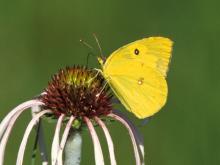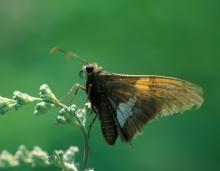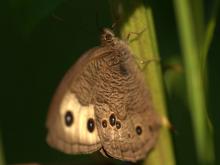Butterflies and Moths
Media

Species Types
Scientific Name
Pterourus troilus
Description
Spicebush swallowtails are beautiful large black butterflies with beautiful iridescent blue-green on the hindwings. The caterpillars eat the leaves of sassafras and spicebush.
Media

Species Types
Scientific Name
Colias philodice
Description
The clouded sulphur is one of our most common butterflies, flying low over fields and lawns, from late March into December.
Media

Species Types
Scientific Name
Phoebis sennae
Description
The cloudless sulphur is the large, clear-yellow butterfly you see flying rapidly to the southward in late summer and fall: They’re migrating!
Media

Species Types
Scientific Name
Colias eurytheme
Description
One of the most common butterflies in Missouri, the orange sulphur often gathers in numbers in moist places.
Media

Species Types
Scientific Name
Zerene cesonia (formerly Colias cesonia)
Description
The southern dogface has a dog’s head pictured on its yellow forewings. It repopulates our state each year from the south.
Media

Species Types
Scientific Name
Epargyreus clarus
Description
In a large, global family of several thousand species, the silver-spotted skipper is one of the easiest to identify in our state.
Media

Species Types
Scientific Name
Euphydryas phaeton ozarkae
Description
The Baltimore checkerspot is unforgettable. In Missouri it is locally abundant in the eastern Ozarks, but rare elsewhere.
Media

Species Types
Scientific Name
Junonia coenia
Description
The common buckeye is one of Missouri’s prettiest butterflies, but it doesn’t overwinter here. Instead, migrants arrive in late spring and early summer.
Media

Species Types
Scientific Name
Cercyonis pegala
Description
Common wood nymphs vary by region. Some have a yellow area on the forewing containing two eyespots. Others may have the yellow area reduced to a yellow circle around each eyespot.
Media

Species Types
Scientific Name
More than 12,000 species in North America north of Mexico
Description
Learn about moths as a group. What makes a moth a moth? How are moths different from butterflies? What are the major groups of moths?
See Also


Media

Species Types
Scientific Name
About 1,500 species in North America north of Mexico
Description
Adult caddisflies are mothlike. Their larvae are aquatic and build portable, protective cases out of local materials, including grains of sand, bits of leaves and twigs, and other debris.
Media

Species Types
Scientific Name
Corydalus cornutus
Description
Adult eastern dobsonflies are huge and mothlike, with large wings and a weak, fluttery flight. The fiercely predaceous aquatic larvae, called hellgrammites, are well-known to anglers, who often use them as bait.
About Butterflies and Moths in Missouri
Butterflies, skippers, and moths belong to an insect order called the Lepidoptera — the "scale-winged" insects. These living jewels have tiny, overlapping scales that cover their wings like shingles. The scales, whether muted or colorful, seem dusty if they rub off on your fingers. Many butterflies and moths are associated with particular types of food plants, which their caterpillars must eat in order to survive.





















